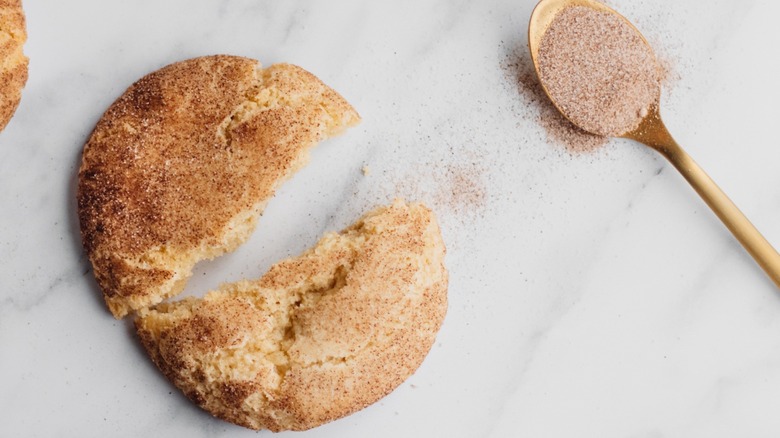The Uncertain History Of How Snickerdoodle Cookies Got Their Name
There are things about the traditional snickerdoodle cookie that we can be absolutely certain of. For starters, their defining characteristic is cinnamon. They should have a bit of a crust on top to crack into, and inside they should be moist and chewy. They are also, obviously, delicious. But one thing we cannot be certain of? Where their quirky name actually comes from. There's a reason that generation after generation of your family has its own fond memories of snickerdoodles growing up — they've been a sweet staple in America since the 19th century. But their history is easier to trace than that of their moniker.
One theory from "The Joy of Cooking," an essential cookbook first published in 1931, ties "snickerdoodle" to "schneckennudel" — the German word that means "snail noodles"– and these cookies were indeed brought to the United States by Dutch and German immigrants. "Snail noodles" is far less appetizing than, say, "cinnamon cookies," and also doesn't do a great job of clarifying things like what these baked goods actually are or how snickerdoodles are different from sugar cookies. And schneckennudeln do indeed exist, but they're cinnamon rolls, not cookies — and their curled up shape could explain the snail link. Beyond cinnamon rolls and snickerdoodles sharing the same spice, though, it's hard to see the connection between schneckennudeln and these cookies.
Other theories on the origin of the snickerdoodle name
Along the lines of the German snail noodle theory is the thinking that snickerdoodles instead got their name from the Dutch word "snekrad," as Dutch immigrants would have also been part of the population bringing these cookies to America. "Snekrad" means "wrinkle" or "crinkle," which could refer to that crinkled, cracked top of the cookie, and it's possible that "snekrad" might have morphed over time into "snicker."
Yet another theory, though, is less structured in historical ties. It is simply that, in New England, people had a habit of referring to cookies with playful nicknames. These labels could be nonsensical and simply fun words to say, which "snickerdoodle" totally fits into. New England is thought to be one of the first American regions where these cookies really took off, so this explanation has a decent shot of being true. One thing we do know about these cookies is that their name, wherever it came from, has been in use almost as long as they've been being baked.
There is, for example, a recipe for snickerdoodles — named as such — developed by Cornelia Campbell Bradford and published by the Cleveland Baking Company all the way back in 1891. At the end of the day, "snickerdoodle" is as fun to say as the cookies are to eat, and the snickerdoodle flavors are also as flexible as this name's origin story. You can even skip the entire cookie framework and make snickerdoodle crumb muffins.

